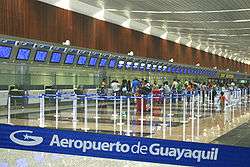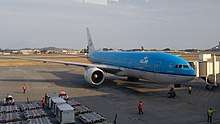José Joaquín de Olmedo International Airport
José Joaquín de Olmedo International Airport (Spanish: Aeropuerto Internacional José Joaquín de Olmedo; IATA: GYE, ICAO: SEGU) is the airport serving Guayaquil, the capital of the Guayas Province and the second most populous city in Ecuador. It is the second busiest airport in Ecuador.
José Joaquín de Olmedo International Airport Ecuador Aeropuerto | |||||||||||
|---|---|---|---|---|---|---|---|---|---|---|---|
 | |||||||||||
| Summary | |||||||||||
| Airport type | Public | ||||||||||
| Operator | Terminal Aeroportuaria de Guayaquil S.A. (TAGSA) | ||||||||||
| Serves | Guayaquil, Ecuador | ||||||||||
| Hub for | LATAM Ecuador | ||||||||||
| Focus city for | Avianca Ecuador | ||||||||||
| Elevation AMSL | 20 ft / 6.1 m | ||||||||||
| Coordinates | 02°09′27″S 79°53′01″W | ||||||||||
| Website | www.tagsa.aero | ||||||||||
| Map | |||||||||||
 GYE Location in Ecuador | |||||||||||
| Runways | |||||||||||
| |||||||||||
| Statistics (2010) | |||||||||||
| |||||||||||
The airport was named after José Joaquín de Olmedo, a notable Ecuadorian poet, first mayor of Guayaquil, and former president of Ecuador. It was changed from Simón Bolívar International Airport, which is currently the name of the airports in Caracas, Venezuela, and Santa Marta, Colombia.
The airport is on the Avenida de las Américas, 5 kilometres (3 mi) north of Guayaquil's centre. The runway length of 2,790 metres (9,150 ft) includes a 240 metres (790 ft) displaced threshold on Runway 21 and a 100 metres (330 ft) displaced threshold on Runway 03. The runway can accommodate Boeing 747 and Airbus A340-600 aircraft. The airport is in the broad delta of the Guayas River, with level terrain in all quadrants.
The Guayaquil VOR-DME (Ident: GYV) is 1.4 nautical miles (2.6 km) off the approach threshold of Runway 21, and the Guayaquil non-directional beacon (Ident: R) is 1.1 nautical miles (2.0 km) off the same runway.[5][6]
In July 2014 the airport domestic area was enlarged; now the airport is capable of handling up to 7.5 million passengers per year. An exit tax is levied on all international tickets, however it is no longer required to pay at the window when exiting the country.[7]
History
The airport, which had the newest terminal in Ecuador, was renamed for José Joaquín de Olmedo in 2006, in preparation for the inauguration of the new 50,000 m2 (540,000 sq ft) national and international terminal on 27 July 2006. Although there was an inaugural flight on 28 July 2006, most airlines did not operate completely from the new terminal until August 2006. After that date, the old terminal was closed and it was later turned into a convention center.
The construction of the new terminal and expansion of the runway was finally decided in 2003–2004, years after making the decision that the current infrastructure was not sufficient to cover the city's needs, but that it was not yet commercially viable to build an entirely new airport in the Daular area.
The original project in 2003–2004 contemplated the construction of a 28,000 m2 (300,000 sq ft) international terminal and the continuing operation of the old terminal, which would be left to handle only domestic flights. However, it was later decided that the newer 50,000 m2 (540,000 sq ft) terminal would handle both national and international traffic, and the older terminal would be closed.
The airport is planned to serve the city of Guayaquil for 10 to 15 years starting in 2006. After this, it is expected to reach a capacity of 5 million passengers a year, and when this happens a new airport will be built in the Daular area, some 20 kilometers outside the city, near the highway that connects Guayaquil to Salinas and other coastal towns.[8]
José Joaquín de Olmedo International Airport was named "Best Airport in Latin America 2008 & 2009" by BusinessWeek[9] and the second best in 2011.[10] All domestic flights going from the Ecuadorian mainland to the Galápagos Islands make a stop in Guayaquil to refuel and pick up passengers due to its location, which is the closest point in Ecuador to the islands.
Airlines and destinations
Passenger

| Airlines | Destinations |
|---|---|
| Air Europa | Madrid |
| American Airlines | Miami |
| Avianca Ecuador | Baltra, Bogotá, Cali, Quito, San Cristóbal |
| Avianca El Salvador | San Salvador (resumes October 25, 2020)[11] |
| Copa Airlines | Panama City–Tocumen |
| Copa Airlines Colombia | Panama City–Tocumen |
| Eastern Airlines | Miami, New York–JFK |
| Iberia | Madrid |
| Interjet | Cancún, Mexico City (both suspended)[12] |
| JetBlue | Fort Lauderdale, New York–JFK |
| KLM | Amsterdam |
| LATAM Ecuador | Baltra, Lima, New York–JFK, Quito, San Cristóbal, Santiago de Chile |
| Plus Ultra Líneas Aéreas | Madrid |
| Spirit Airlines | Fort Lauderdale |
| Wingo | Bogotá |
Cargo
| Airlines | Destinations |
|---|---|
| Avianca Cargo | Quito |
| UPS Airlines | Miami |
Statistics
| Rank | Change | City | Passengers | % Change | Top carriers |
|---|---|---|---|---|---|
| 1 | 420.244 | Copa Airlines | |||
| 2 | 267.958 | Avianca Ecuador | |||
| 3 | 232.521 | American Airlines | |||
| 4 | 178.191 | Avianca Ecuador, LATAM Ecuador | |||
| 5 | 161.076 | LATAM Ecuador | |||
| 6 | 133.062 | Air Europa, Iberia | |||
| 7 | 118.050 | JetBlue Airways | |||
| 8 | 102.733 | KLM | |||
| 9 | 101.293 | LATAM Ecuador | |||
| 10 | 60.378 | Avianca El Salvador | |||
| 11 | 58.571 | Avianca Ecuador | |||
| 12 | 21.942 | Avior Airlines | |||
| 13 | New | 19.409 | Avior Airlines |
| Rank | Change | City | Passengers | % Change | Top carriers |
|---|---|---|---|---|---|
| 1 | 1,512,209 | Avianca Ecuador, LATAM Ecuador, TAME | |||
| 2 | 229.034 | Avianca Ecuador, LATAM Ecuador, TAME | |||
| 3 | 102.745 | Avianca Ecuador, LATAM Ecuador, TAME | |||
| 4 | 7.590 | TAME | |||
| 5 | 2.180 | TAME |
Accolades
- 2011 – 2nd Best Airport in Latin America – Caribbean of the Airport Service Quality Awards by Airports Council International[10] and Best Airport by Size in the 2 to 5 million passenger category.[14]
References
- Terminal Aeroportuaria de Guayaquil S.A. (TAGSA) (in Spanish) Archived 9 March 2010 at the Wayback Machine
- Airport information for SEGU from DAFIF (effective October 2006)
- Google Maps - Guayaquil
- Airport information for Olmedo International Airport at Great Circle Mapper.
- Guayaquil VOR
- Guayaquil NDB
- "Ecuador, Airport Exit Tax To Be Included in Purchase of Ticket". Latin America Current Events & News. 4 February 2011. Retrieved 1 June 2012.
- "Timetable". Guayaquil Airport. 2012. Retrieved 1 June 2012.
- "The World's Best Airports 2009". Bloomberg BusinessWeek. 2009. Retrieved 7 July 2014.
- "ASQ Award for Best Airport in Latin America – Caribbean" Airports Council International. 14 February 2012. Retrieved 13 April 2012
- "Avianca reviews the restart of its flights in Central America". Nicolás Larenas (in Spanish). August 2020. Retrieved 8 August 2020.
- "Interjet limits its operation to 6 destinations". EnElAire (in Spanish). May 2020. Retrieved 6 May 2020.
- "https://www.ecuadorencifras.gob.ec/transporte/"
- "ASQ Award for Best Airport by Size (2–5m)" Airports Council International. 14 February 2012. Retrieved 13 April 2012
External links
![]()
- Jose Joaquin de Olmedo Airport at OpenStreetMap
- José Joaquín de Olmedo International Airport at OurAirports
- Aeronautical chart and airport information for Guayaquil/Jose J De Olmedo Airport at SkyVector
- Current weather for Guayaquil / Simon Bolivar at NOAA/NWS
- Accident history for Guayaquil-Simon Bolivar Airport at Aviation Safety Network
- Autoridad Aeroportuaria de Guayaquil (in Spanish)
- Accommodations near the airport in Guayaquil (in Spanish)